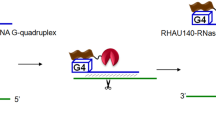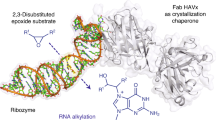Abstract
SHORTENED forms of the group I intron from Tetrahymena catalyse sequence-specific cleavage of exogenous oligonucleotide substrates1,2. The association between RNA enzyme (ribozyme) and substrate is mediated by pairing between an internal guide sequence on the ribozyme and a complementary sequence on the substrate1,3,4. RNA substrates and cleavage products associate with a binding energy greater than that of base-pairing by ∼4 kcal mol−1 (at 42°C), whereas DNA associates with an energy around that expected for base-pairing5–9. It has been proposed that the difference in binding affinity is due to specific 2′-OH groups on an RNA substrate forming stabilizing tertiary interactions with the core of the ribozyme, or that the RNA-RNA helix formed upon association of an RNA substrate and the ribozyme might be more stable than an RNA-DNA helix of the same sequence6. To differentiate between these two models, chimaeric oligonucleotides containing deoxynucleotide residues at successive positions along the chain were synthesized, and their equilibrium binding constants for association with the ribozyme were measured directly by a new gel electrophoresis technique5. We report here that most of the extra binding energy can be accounted for by discrete RNA–ribozyme interactions, the 2′-OH group on the sugar residue three nucleotides from the cleavage site contributing the most interaction energy. Thus, in addition to the well documented binding of RNA to RNA by base-pairing10–14, 2′-OH groups within a duplex can also mediate association between RNA molecules.
This is a preview of subscription content, access via your institution
Access options
Subscribe to this journal
Receive 51 print issues and online access
$199.00 per year
only $3.90 per issue
Buy this article
- Purchase on Springer Link
- Instant access to full article PDF
Prices may be subject to local taxes which are calculated during checkout
Similar content being viewed by others
References
Zaug, A. J., Been, M. D. & Cech, T. R. Nature 324, 429–433 (1986).
Zaug, A. J., Grosshans, C. A. & Cech, T. R. Biochemistry 27, 8924–8930 (1988).
Davies, R. W., Waring, R. B., Ray, J. A., Brawn, T. A. & Scazzocchio, C. Nature 300, 719–724 (1982).
Been, M. D. & Cech, T. R. Cell 47, 207–216 (1986).
Pyle, A. M., McSwiggen, J. A. & Cech, T. R. Proc. natn. Acad. Sci. U.S.A. 87, 8187–8191 (1990).
Herschlag, D. & Cech, T. R. Nature 344, 405–409 (1990).
Herschlag, D. & Cech, T. R. Biochemistry 29, 10159–10171 (1990).
Sugimoto, N., Kierzek, R. & Turner, D. H. Biochemistry 27, 6384–6392 (1988).
Sugimoto, N., Tomka, M., Kierzek, R., Bevilacqua, P. & Turner, D. H. Nucleic Acids Res. 17, 355–371 (1989).
Crick, F. H. C. J. molec. Biol. 19, 548–555 (1966).
Shine, J. & Dalgarno, L. Proc. natn. Acad. Sci. U.S.A. 71, 1342–1346 (1974).
Tomizawa, J. Cell 38, 861–870 (1984).
Lerner, M. R., Boyle, J. A., Mount, S. A., Wolin, S. L. & Steitz, J. A. Nature 283, 220–224 (1980).
Guthrie, C. & Patterson, B. A. Rev. Genet. 22, 387–419 (1988).
Martin, F. H. & Tinoco, I. Jr. Nucleic Acids Res. 8, 2295–2300 (1980).
Nelson, J. W. & Tinoco, I. Jr. Biochemistry 21, 5289–5295 (1982).
Been, M. D. & Cech, T. R. Cell 50, 951–961 (1987).
Wells, N. C. & Fersht, A. R. Nature 316, 656–657 (1985).
Turner, D. H., Sugimoto, N., Kierzek, R. & Dreiker, S. D. J. Am. chem. Soc. 109, 3783–3785 (1987).
Quigley, G. J. & Rich, A. Science 194, 796–806 (1976).
Dix, D. B., Wittenberg, W. L., Uhlenbeck, O. C. & Thompson, R. C. J. biol. Chem. 261, 10112–10118 (1986).
Dock-Bregeon, A. C. et al. J. molec. Biol. 209, 459–474 (1989).
Bass, B. L. & Cech, T. R. Biochemistry 25, 4473–4477 (1986).
Perreault, J.-P., Wu, T., Cousineau, B., Ogilvie, K. K. & Cedergren, R. Nature 344, 565–567 (1990).
Yang, J., Perreault, J.-P., Labuda, D., Usman, N. & Cedergren, R. Biochemistry 29, 11156–11160 (1990).
Dahm, S. C. & Uhlenbeck, O. C. Biochimie 72, 819–823 (1990).
Michel, F. & Westhof, E. J. molec. Biol. 216, 585–610 (1990).
Wu, T., Ogilvie, K. K. & Pon, R. T. Nucleic Acids Res. 9, 3501–3517 (1989).
Scaringe, S. A., Francklyn, C. & Ussman, N. Nucleic Acids Res. 18, 5433–5441 (1990).
Michel, F., Jacquier, A. & Dujon, B. Biochimie 64, 867–881 (1982).
Waring, R. J., Towner, P., Minter, S. J. & Davies, R. W. Nature 321, 133–139 (1986).
Author information
Authors and Affiliations
Rights and permissions
About this article
Cite this article
Pyle, A., Cech, T. Ribozyme recognition of RNA by tertiary interactions with specific ribose 2′-OH groups. Nature 350, 628–631 (1991). https://doi.org/10.1038/350628a0
Received:
Accepted:
Issue Date:
DOI: https://doi.org/10.1038/350628a0
This article is cited by
-
Evolutionary origin of a plant mitochondrial group II intron from a reverse transcriptase/maturase-encoding ancestor
Journal of Plant Research (2006)
-
Bacterial virus phi29 pRNA as a hammerhead ribozyme escort to destroy hepatitis B virus
Gene Therapy (2003)
-
A minor groove RNA triple helix within the catalytic core of a group I intron
Nature Structural Biology (1998)
-
RNA aptamers
Nature Structural Biology (1997)
-
Isolation of a local tertiary folding transition in the context of a globally folded RNA
Nature Structural & Molecular Biology (1996)
Comments
By submitting a comment you agree to abide by our Terms and Community Guidelines. If you find something abusive or that does not comply with our terms or guidelines please flag it as inappropriate.



